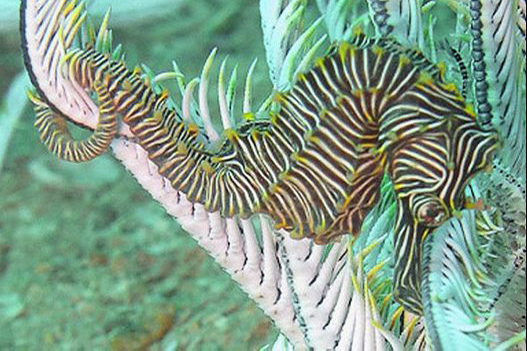Zebra Seahorse, Hippocampus zebra Whitley 1964

A Zebra Seahorse, Hippocampus zebra, clinging to a crinoid (featherstar) on a sandy bottom at Port Hedland, Western Australia - depth 13 m. Source: Tony Ayling. License: All rights reserved
A tropical seahorse with alternating pale and dark zebra-like bands and stripes on the head and body, and often yellow tips on the spines. Lourie et al. (2016) determined that Hippocampus montebelloensis is a junior synonym of H. zebra.
Zebra Seahorse, Hippocampus zebra Whitley 1964
More Info
|
Distribution |
Exmouth Gulf to Port Hedland, Western Australia, and off Cape Grenville to Northwest Island, Capricorn Group, Queensland. Elsewhere the species occurs in New Guinea. Possibly associated with crinoids, black coral or gorgonians in depths of 20-70 m. |
|
Features |
Dorsal fin 17-19; Anal fin 4; Pectoral fin 15-16; trunk rings 11; tail rings 37-39; subdorsal rings 2-3 + 1. Lateral line: Lateral line present with pores detectable to about 14th tail ring. |
|
Size |
|
|
Colour |
In life, alternating yellowish-white and brown to black bands, most transverse, some oblique or curved on the head and belly; eye blue with yellowish-white iris; chin yellowish-white, without dark bands; fins lighter; dorsal and anal fins brown proximally; tips of spines often yellow. In preservative - as in life, with alternating bands of white to brownish-white and dark brown to black |
|
Feeding |
Like most other seahorses, this species presumably feeds by sucking small prey items such as crustaceans and planktonic zooplankton into its mouth. |
|
Biology |
Sexes separate, males brood the eggs in a pouch, and gives birth to tiny independent young. The female uses an ovipositor to transfer her eggs into an elaborate enclosed pouch under the abdomen of the male. The male not only fertilizes the eggs inside the pouch and provides physical protection for the developing embryos, he also osmoregulates and aerates the embryos and may provide some nourishment until the offfspring are born. |
|
Fisheries |
|
|
Conservation |
Listed under Appendix II of the Convention on the International Trade in Endangered Species of Wild Flora and Fauna (CITES). As a result, the species is subject to the Convention, http://www.cites.org/. |
|
Remarks |
The zebra-like markings may provide effective camouflage on black coral fans or gorgonians, as the species may mimic black and white basket stars inhabiting these corals. |
|
Similar Species |
H. zebra is similar to H. dahli, which has a much lower coronet and the upper tubercle on the shoulder ring is near the gill opening. |
|
Etymology |
The specific name zebra refers to the black and white striped markings of this species. |
|
Species Citation |
Hippocampus zebra Whitley 1964, Rec. Aust. Mus. 26(5): 164, Pl. 8, off Gillett Cay, Swain Reefs, Queensland, Australia. |
|
Author |
Bray, D.J. & Thompson, V.J. 2017 |
|
Resources |
Zebra Seahorse, Hippocampus zebra Whitley 1964
References
Gomon, M.F. 1997. A remarkable new pygmy seahorse (Syngnathidae Hippocampus) from south-eastern Australia, with a redescription of H. bargibanti Whitley from New Caledonia. Memoirs of Museum Victoria 56(1): 245-253
Horne, M.L. 2001. A new seahorse species (Syngnathidae: Hippocampus) from the Great Barrier Reef. Records of the Australian Museum 53(2): 243-246
Johnson, J.W. 1999. Annotated checklist of the fishes of Moreton Bay, Queensland, Australia. Memoirs of the Queensland Museum 43(2): 709-762
Kuiter, R.H. 2000. Seahorses, Pipefishes and their Relatives. TMC Publishing, Chorleywood, UK, 240 pp.
Kuiter, R.H. 2001. Revision of the Australian Seahorse of the genus Hippocampus (Syngnathiformes: Syngnathidae) with descriptions of nine new species. Rec. Aust. Mus. 53: 293-340. (as Hippocampus montebelloensis and H. zebra)
Lourie, S.A., Pollom, R.A. & Foster, S.J. 2016. A global revision of the Seahorses Hippocampus Rafinesque 1810 (Actinopterygii: Syngnathiformes): Taxonomy and biogeography with recommendations for further research. Zootaxa 4146(1): 1–66.
Lourie, S.A., Vincent, A.C.J. & Hall, H.J. 1999. Seahorses. An identification guide to the world's species and their conservation. Project Seahorse. x 214 pp.
Pogonoski, J.J., D.A. Pollard & J.R. Paxton. 2002. Conservation Overview and Action Plan for Australian Threatened and Potentially Threatened Marine and Estuarine Fishes. Canberra, Environment Australia, 375 pp.
Whitley, G.P. 1964. Fishes from the Coral Sea and the Swain Reefs. Records of the Australian Museum 26(5): 145-195 figs 1-15 pls 8-10




